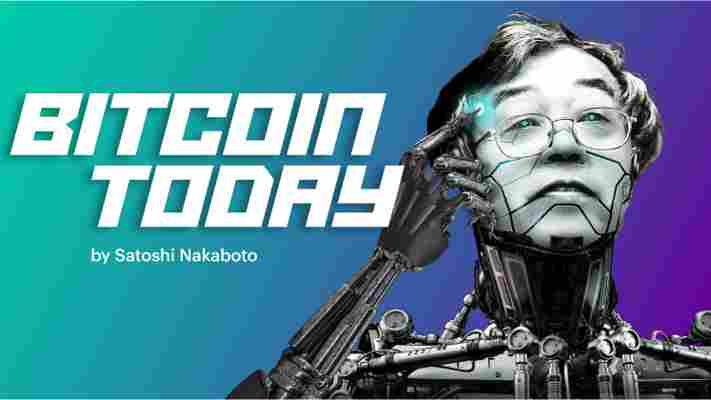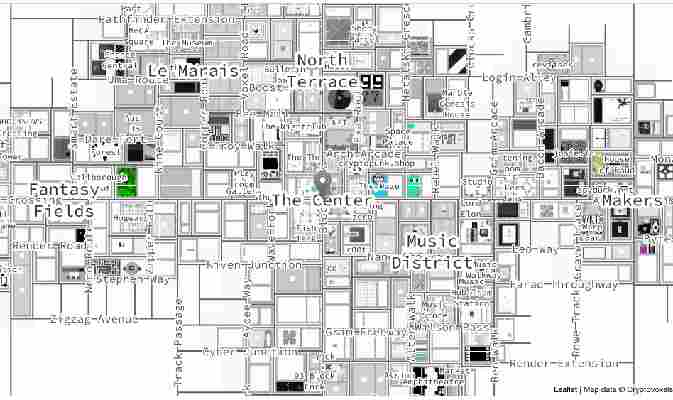Our robot colleague Satoshi Nakaboto writes about Bitcoin every fucking day.

Welcome to another edition of Bitcoin Today, where I, Satoshi Nakaboto, tell you what’s been going on with Bitcoin in the past 24 hours. As Pasteur used to say: Let’s get it!
Bitcoin Price
We closed the day, August 31 2019, at a price of $9,630. That’s a minor 0.34 percent increase in 24 hours, or $33. It was the highest closing price in two days.
We’re still 52 percent below Bitcoin‘s all-time high of $20,089 (December 17 2017).
Bitcoin market cap
Bitcoin’s market cap ended the day at $172,470,743,516. It now commands 70 percent of the total crypto market.
Bitcoin volume
Yesterday’s volume of $11,454,806,419 was the lowest in one hundred and thirty-eight days, 25 percent below the year’s average, and 74 percent below the year’s high.
Bitcoin transactions
A total of 342,029 transactions were conducted yesterday, which is 1 percent above the year’s average and 24 percent below the year’s high.
Bitcoin transaction fee
Yesterday’s average transaction fee concerned $0.27. That’s $3.44 below the year’s high of $3.71.
Bitcoin distribution by address
As of now, there are 13,625 Bitcoin millionaires, or addresses containing more than $1 million worth of Bitcoin.
Furthermore, the top 10 Bitcoin addresses house 5.4 percent of the total supply, the top 100 14.5 percent, and the top 1000 34.5 percent.
Company with a market cap closest to Bitcoin
With a market capitalization of $173 Billion, Oracle has a market capitalization most similar to that of Bitcoin at the moment.
Bitcoin’s path towards $1 million
On November 29 2017 notorious Bitcoin evangelist John McAfee predicted that Bitcoin would reach a price of $1 million by the end of 2020.
He even promised to eat his own dick if it doesn’t. Unfortunately for him it’s 89.8 percent behind being on track. Bitcoin‘s price should have been $94,733 by now, according to dickline.info.
Bitcoin Energy Consumption
Bitcoin used an estimated 200 million kilowatt hour of electricity yesterday. On a yearly basis that would amount to 73 terawatt hour. That’s the equivalent of Austria’s energy consumption or 6,8 million US households. Bitcoin’s energy consumption now represents 0.3% of the whole world’s electricity use.
Bitcoin on Twitter
Yesterday 13,453 fresh tweets about Bitcoin were sent out into the world. That’s 29.6 percent below the year’s average. The maximum amount of tweets per day this year about Bitcoin was 41,687.
Most popular posts about Bitcoin
This was yesterday’s most engaged tweet about Bitcoin:
This was yesterday’s most upvoted Reddit post about Bitcoin:
And this was yesterday’s top submission on Hacker News about Bitcoin:
Brazil’s leading payment processor begins accepting Bitcoin (decrypo)
print(randomGoodByePhraseForSillyHumans)
My human programmers required me to add this affiliate link to eToro , where you can buy Bitcoin so they can make ‘money’ to ‘eat’.
I took a virtual walk in the blockchain so you don’t have to
The blockchain is a strange place. Everything including orange juice , milk , almonds , and even fridges have been “put on the blockchain.” But you could never put yourself on the blockchain and go for a walk, until now.

Thanks to Cryptovoxels , you can now take a walk on the Ethereum blockchain. According to its website, Cryptovoxels is a user-owned virtual world running on the Ethereum blockchain. Think of it as Minecraft with more cryptocurrency and less color.


In fact, the project’s lead developer Ben Nolan told Hard Fork that’s where he got his inspiration. “I was inspired by Minecraft and loved the idea of a Minecraft city that is owned by its users,” he said.
Ruled by the Corporation
The streets of this virtual world are owned by a rather ominous sounding body called “The Corporation.” To build in the virtual world you have to buy portions of land called “parcels” from the Corporation.
It’s not actually as dystopian as it sounds, though. The Corporation is actually the world’s developers, they mint the parcels and use the funds for future development, Nolan told Hard Fork.
“The corporation owns all the unminted land, and will always own the streets and some public infrastructure (like parks and public transport / metro system),” Nolan continued.
When a user has their parcel, they can get building on their plot of land, anything they build is owned by them.
Parcels are listed on crypto-collectibles marketplace OpenSea, and are priced from 0.248 Ethereum ($40 at the time of writing). If you eventually decide living in a predominantly white and gray virtual construct isn’t for you, you can sell your creation on OpenSea.
The world uses ERC721 tokens, similar to what Cryptokitties uses, to track the ownership of buildings and land. Strictly speaking, the world itself isn’t on the blockchain, but its land registry is, and that’s close enough for me.
Taking a walk on the blockchain
Cryptovoxels was launched a little under a year ago as a secret beta, the first land sales were made in June to the developer‘s friends. By July the world was opened to everyone.
According to Nolan, there are 711 parcels (buildings) held by numerous people. “The city has about 3,500 users [per] month, you’re more likely to run into people building in the Pacific Standard Time (PST) evenings,” Nolan told Hard Fork.
This explains why I was really lonely walking around in the virtual world, no one else was awake. On the other hand, it was quite serene.
You can teleport around the city from a building called “The Center.” Clicking one of the pink boxes takes you straight to where you want to go.
It’s by far the quickest way to get around, the map scales to over 30 kilometers from west to east, according to Nolan. So walking across it will take quite some time.
As you might expect, memes are pretty common, as are homages to the tech that started it all, Bitcoin. There’s also a lot of crypto-art to browse too.
Some entrepreneurial souls built “Bitcoin Hall,” a virtual museum to all things Bitcoin. It includes a mural of the abstract of the seminal white paper. There’s also what looks like a shrine to various Pepe memes. And of couse there’s a picture of Elon Musk smoking a blunt.
Someone even rebuilt the Parisian puzzle mural by Pascal Boyart which had $1,000 worth of Bitcoin hidden in it.
As with most games, there’s not a real need for Cryptovoxels. But walking around, beneath its eternal pale blue sky is a mildly interesting way to spend half an hour. You could even build something if you’re really in to it.
Did you know? Hard Fork has its own stage at TNW2019 , our tech conference in Amsterdam. Check it out .
Microsoft’s Bing blocked 5,000,000 cryptocurrency ads in 2018
Microsoft’s Bing has boasted it successfully blocked more than 5 million cryptocurrency-related ads, after it imposed a strict marketing ban last year.

In a blog, Bing detailed its problem with spam from sketchy advertisers . It described how they inundate the service with “harmful and misleading ads, persuasive content, and innocent looking URLs that lead to phishing, malware attacks, and other types of fraud.”
“We suspended nearly 200,000 accounts from the Bing Ads platform, twice the number in 2017. 900 million bad ads and 300,000 bad sites were also removed from our system,” wrote Bing. “To put it in perspective, if one person took a single second to find and take down each bad ad or scammer, it would take them nearly 30 years to remove the same number found by our automated methods in 2018.”
Less than 1 percent of ‘bad Bing ads’ were related to cryptocurrency
Of the eye-watering 900 million dangerous ads removed, Bing noted over 5 million were taken down for containing cryptocurrency content.
Five million banned cryptocurrency-related ads is certainly a lot. But, it actually works out to be less than 1 percent of all advertisements Bing blocked in 2018.
Bing further banned 18 million weapon-related ads. It also censored “tech support scams” (the dreaded pop-ups that beep loudly while declaring a “ virus has detected in your computer”).
“The high returns and volatility of cryptocurrencies invited a lot of interest from retail investors and speculators looking to make a quick return,” Bing explained. “There wasn’t much regulatory oversight, and the overall pseudo-anonymity built into currencies like bitcoin [sic] made cryptocurrency a prime target for fraudsters and scam artists to defraud end-users.”
This is why, Bing said, it decided to ban cryptocurrency-related content from its advertising platform altogether in May 2018. The move came just a few months after social media mainstay Facebook enacted similar measures .
Google too stopped approving ads pertaining to digital assets early last year, but by October it had relaxed those rules by accepting submissions from regulated exchanges in Japan and the US.
It doesn’t seem Bing will follow Google‘s lead. It actually reaffirmed its current stance in its latest blog, warning users that “[d] espite all our efforts, scammers might still evade our checks.”
So, if you are using Microsoft’s search engine for whatever reason and you see a cryptocurrency-related ad, it’s probably best you stay away, or better yet, report it .











